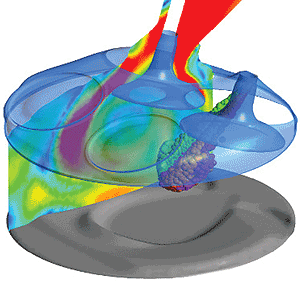Fluid Structure Interaction (FSI)
In modern industrial product design, multi-physics simulations are carried out to capture the interaction between different physical phenomena. A Fluid Structure Interaction (FSI) analysis describes the response of a physical structure to the fluid flow. For this, the dynamics of both the fluid and the structure must be modeled. More advanced applications of multi-physics analyses can involve thermo-fluid-dynamics to be coupled with electromagnetism and acoustics.
Industries that rely on FSI Analyses
FSI analysis can be successfully applied to many industrial applications such as:
- Power generation, turbo-machinery industry: aero-elasticity, wind turbines, gas, steam and hydraulic turbines, all type of pumps, compressors, electric motors, heat exchangers, combustion chambers
- Automotive, transport industry: hybrid electric vehicle (HEV), engine cooling systems, fans, aero-acoustics
- Aerospace, naval industry: aero-elasticity, wing design, flutter phenomena, propellers, sink, trim and floating calculation
- Chemical and process industry: flow induced vibrations, pipelines with pulsating flows and water hammer effect, compressors, pulsed columns, burners and reactors
- Civil engineering: wind induced oscillations on bridges, chimneys, towers, skyscrapers
The Multi-physics Fluid Structure Interaction from the Numerical Perspective

Using numerical methods it is possible to understand and predict fluid-structure phenomena. This multi-physics simulation requires the coupling of two or more simulation tools such as CFD, FEM, electromagnetic or acoustic solvers.
An FSI analysis can involve:
- 1-way FSI: pressure and temperature distributions calculated via CFD are transferred to a structural model as load conditions. The structural deformation does not affect the flow field
- 2-way FSI: a transient analysis that couples CFD and FEM. At each time-step, loads are transferred from CFD to FEM and deformations are transferred back from FEM to CFD in an iterative process
- interaction between CFD and rigid body, 6 degrees of freedom solver
- immersed solid: a technique that allows the effect of a moving body, such as a gear or piston pump, immersed in a fluid to be calculated
- coupling of electromagnetic, CFD and FEM simulations (electric motors, HEV)
- aero-acoustics: noise source is calculated via CFD and transferred to an acoustic solver
The Outstanding Advantages Derived from Multi-Physics Simulations
A multi-physics simulation is a process that is able to completely describe all the phenomena that determine the behavior of complex industrial products. It provides a deep insight into phenomena that would otherwise hardly be observable or measurable. The advantages of making good use of multi-physics analyses in the design phase of products are numerous and benefit both industry and the ultimate consumers. Among these we can highlight:
- longer life and improved robustness in systems that are affected by vibrations or fluctuating flows
- noise reduction
- increased efficiency of devices in which there is a strict correlation between the electromagnetic, cooling, and structural resistance
- improved pumps/compressors/fans performances and robustness
- increased production: filling machines, wind, steam, gas, hydraulic turbines
